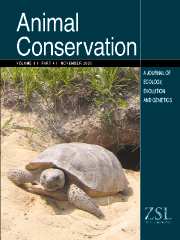Article contents
Genetic variability and population structure among wild Baird's tapirs
Published online by Cambridge University Press: 11 May 2004
Abstract
Baird's tapir, Tapirus bairdii, is an endangered, large, Central American mammal whose shy behaviour, solitary social structure and preference for deep tropical forests make it difficult to study using traditional field biology techniques. Despite great concern regarding its conservation status, very little is known about its population structure, mating system or dispersal patterns, information needed for designing appropriate management plans. Molecular genetic approaches can be of use in obtaining such information. In this study, we developed six polymorphic microsatellite genetic markers from genomic libraries of T. bairdii and T. terrestris. Using these markers, we completed the first assessment of genetic variability and population genetic structure in Baird's tapirs. Populations from southern Costa Rica and southern Panama were found to have low levels of genetic variability (allelic content, heterozygosity) but no indication of a recent population bottleneck. Bayesian and standard (F-statistic) analyses of genotype data indicate that the southern Costa Rican and southern Panamanian populations of Baird's tapirs were connected by some (at least one migrant per generation) gene flow prior to the destruction of intermittent habitat. These results indicate that the connection of these two populations by a MesoAmerican Biological Corridor (MBC) would be appropriate.
- Type
- Research Article
- Information
- Copyright
- 2004 The Zoological Society of London
- 12
- Cited by


